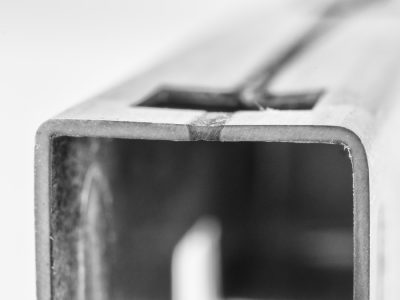Although welding has existed since ancient times, it has never been as refined and innovative as it is today.
There are several different welding methods, with laser welding as one of the most common. Laser welding poses minimal risk in terms of deformation, is quick, and allows for single-sided access to the weld joint.
Welding – joining pieces of metal by fusion
Welding is a technique for joining metal. It involves heating up the joint between pieces of metal to fuse them together and create a welded joint.
Methods for spot welding, fusion welding, and other welding
Methods for spot welding, fusion welding, and other welding
The energy required to fuse the metals can come from a gas flame, electric arc, electron beam, laser, friction, ultrasound, or high pressure, such as by way of an explosion. The different welding methods can be broken down into spot welding methods, fusion welding methods, and other welding methods. In spot welding, pressure is used to perform the weld, with or without heat. Fusion welding heats up the joint surfaces to melting point, fusing them together with or without the use of an additive.
Welding using lasers involves localised heating without affecting the surrounding material
Laser welding is a welding method that uses a high-energy-density laser beam to heat only a selected local area. The process is so quick that the product is welded before the heat can spread to the surrounding material. This ensures a minimal impact from heat and therefore poses little risk of deformation. In addition, the processing speed is often much quicker than in conventional welding.
The laser beam is controlled with a very high level of accuracy, which makes it possible to join materials that were previously difficult to join together, such as aluminium and copper (due to their different melting points). The high degree of precision also makes it possible to attach thin foils to thick substances. In many industries where there is a need for single-sided welding, laser welding is an excellent alternative. As the laser beam melts exactly the right amount of material, a joint is created that has extremely fine tolerances and rarely needs any post-processing such as straightening, grinding, or polishing.
What does Permanova offer?
Permanova’s laser-based welding equipment is used in many places all over the world. In most cases, these are robot-based systems with a high degree of automation. Permanova’s customer base includes small and large companies in general industry, the automotive industry, and the aerospace industry. Welding systems have always been a major part of Permanova’s business, and we can see that this is continuing to grow.
For laser welding to be the right joining method for a product, a joint is required that has a good fit, large volumes, and high expectations in terms of quality. We work with the customer in our lab to design a welding process in terms of parameters, geometry, and quality. Based on the lab result, we design the power of the laser source, the accuracy and reach of the robot, and the configuration of the welding optics. We ensure that we tailor the solution based on the customer’s product and production conditions.
Keyhole welding versus heat conduction welding – two laser welding methods
Laser welding can be broken down into two types – keyhole welding and heat conduction welding.
Keyhole welding offers minimal thermal stress and deformation
In keyhole welding, the high-intensity laser beam creates a plasma hole in the material, causing a small amount of the material to evaporate. The evaporated material creates high pressure that pushes the molten material aside so that the beam can penetrate deeper into the material compared with heat conduction welding, for example. This results in a deep and quick weld with minimal heat impact on the base material, and thus minimal thermal stress and deformation. In addition to its substantially lower level of heat conduction to the material and thus its smaller impact on shape, keyhole welding is a much quicker method than traditional welding. Typically, laser welding speeds are five to ten times quicker than TIG welding, for example.
Heat conduction welding results in an attractive weld surface
In the case of heat conduction welding, the laser beam heats the top of the material to the welded. The heat is then passed down into the material to penetrate the weld. This welding method is primarily used for thinner materials. The advantage of heat conduction welding compared with conventional welding methods is that it is easier to achieve an attractive weld surface.

